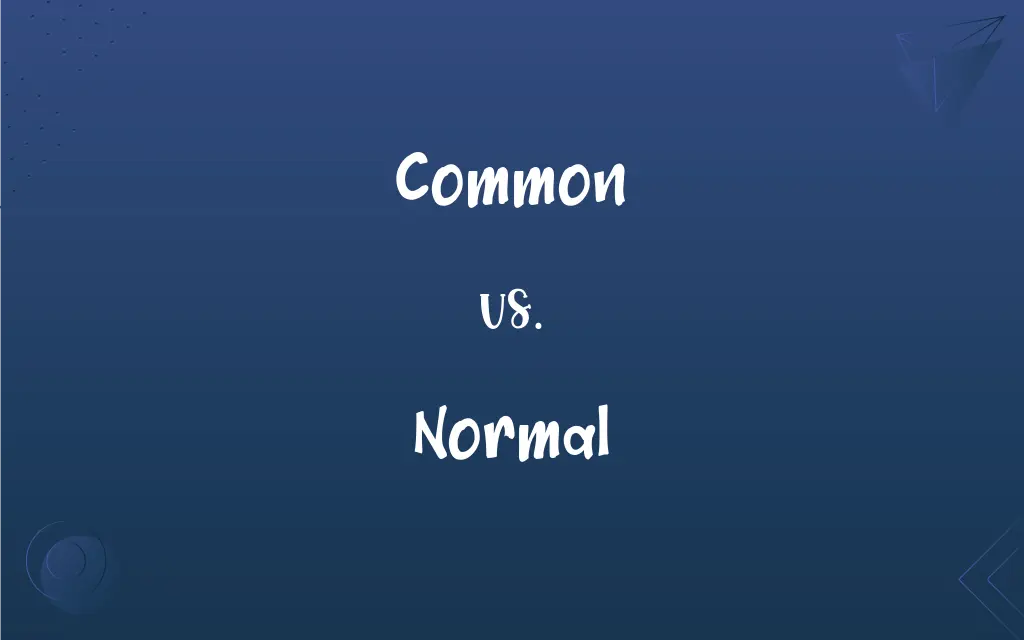Common vs. Normal: What's the Difference?
Edited by Aimie Carlson || By Harlon Moss || Published on December 28, 2023
Common refers to something frequently encountered or widely accepted, while normal denotes something conforming to a standard or what is expected.

Key Differences
Common implies something that is usual or prevalent in a particular context, suggesting frequency or widespread occurrence. Conversely, normal refers to what is standard, typical, or expected under specific conditions, emphasizing conformity to a known pattern or average.
The term common often carries a neutral or sometimes negative connotation, as in something ordinary or unremarkable. In contrast, normal is used to describe a state of being that aligns with established norms or standards, implying regularity and absence of abnormalities.
When discussing behavior or phenomena, common suggests something that is observed often and by many. However, normal is used to indicate that something falls within the range of accepted standards, not deviating from what is typical or expected.
In language and communication, common can refer to terms or expressions widely used and understood, whereas normal is used to describe language that adheres to the standard rules and structures.
Common might be used to denote shared traits or characteristics in a group, while normal often refers to an ideal or baseline condition from which deviations are measured.
ADVERTISEMENT
Comparison Chart
Connotation
Often neutral or mundane
Conforms to standard or expectation
Usage in Language
Refers to widespread use or acceptance
Indicates adherence to standard rules
In Context of Behavior
Suggests frequent occurrence or prevalence
Implies being within accepted standards
In Statistics
Refers to the most occurring or typical instances
Relates to average or expected values
In Terms of Rarity
Common items or occurrences are not rare
Normal situations are not necessarily common
ADVERTISEMENT
Common and Normal Definitions
Common
Shared by, coming from, or done by more than one.
The common goal united the team.
Normal
Regular; not abnormal.
The doctor said her vital signs were normal.
Common
Frequently found or seen; widespread.
Colds are common during the winter.
Normal
Standardized; conforming to the usual.
They resumed their normal activities.
Common
Ordinary, without special rank or status.
They lived in a common neighborhood.
Normal
Conforming to a standard; usual, typical, or expected.
It's normal to feel nervous before a test.
Common
Widely known or recognized.
It's common knowledge that the sun rises in the east.
Normal
Free from any mental disorder; sane.
His behavior seemed perfectly normal.
Common
Lacking refinement or cultivation.
His manners were too common for the formal event.
Normal
Relating to an average or a general level.
Temperatures are above normal for this time of year.
Common
Belonging equally to or shared equally by two or more; joint
Common interests.
Normal
Conforming with, adhering to, or constituting a norm, standard, pattern, level, or type; typical
Normal room temperature.
One's normal weight.
Normal diplomatic relations.
FAQs
Is 'normal' always synonymous with 'common'?
No, 'normal' refers to what's typical or standard, which isn't always common.
What does 'common' typically refer to?
It refers to something prevalent, ordinary, or widely accepted.
Does 'normal' imply conformity?
Yes, it suggests conformity to an expected standard or norm.
Can 'common' have a negative connotation?
Yes, it can imply something ordinary or unremarkable.
Is 'common' used to describe shared traits?
Yes, it can denote characteristics shared by a group.
Can 'common' describe widespread language usage?
Yes, it's used for terms or expressions widely understood.
Does 'normal' indicate mental health?
In certain contexts, it can refer to mental stability or average mental condition.
Can something be normal but not common?
Yes, some normal things may not be commonly encountered.
Is 'common' used in legal terms?
Yes, like in 'common law', referring to laws based on customs and judicial decisions.
Does 'common' have different meanings in different fields?
Yes, its meaning can vary in areas like law, medicine, and language.
Does 'normal' apply to statistical averages?
Yes, it refers to average or expected values in statistics.
Can 'common' refer to lower social status?
Historically, yes, but it's less common in modern usage.
Is 'normal' always desirable?
Not necessarily, as societal norms can vary and be subjective.
Can 'normal' be subjective?
Yes, perceptions of what is normal can be influenced by personal or cultural views.
Is 'common' used in scientific terms?
Yes, to refer to frequently observed phenomena or species.
Does 'common' imply mediocrity?
Sometimes, especially when used to describe quality.
Is 'common' always easy to define?
Not always, as it can be subjective and context-dependent.
Does 'normal' mean the same in all cultures?
No, what's considered normal can vary greatly across cultures.
Can 'normal' change over time?
Yes, societal norms evolve and change over time.
Can 'normal' refer to physical health?
Yes, it can denote typical or healthy physical conditions.
About Author
Written by
Harlon MossHarlon is a seasoned quality moderator and accomplished content writer for Difference Wiki. An alumnus of the prestigious University of California, he earned his degree in Computer Science. Leveraging his academic background, Harlon brings a meticulous and informed perspective to his work, ensuring content accuracy and excellence.
Edited by
Aimie CarlsonAimie Carlson, holding a master's degree in English literature, is a fervent English language enthusiast. She lends her writing talents to Difference Wiki, a prominent website that specializes in comparisons, offering readers insightful analyses that both captivate and inform.






































































